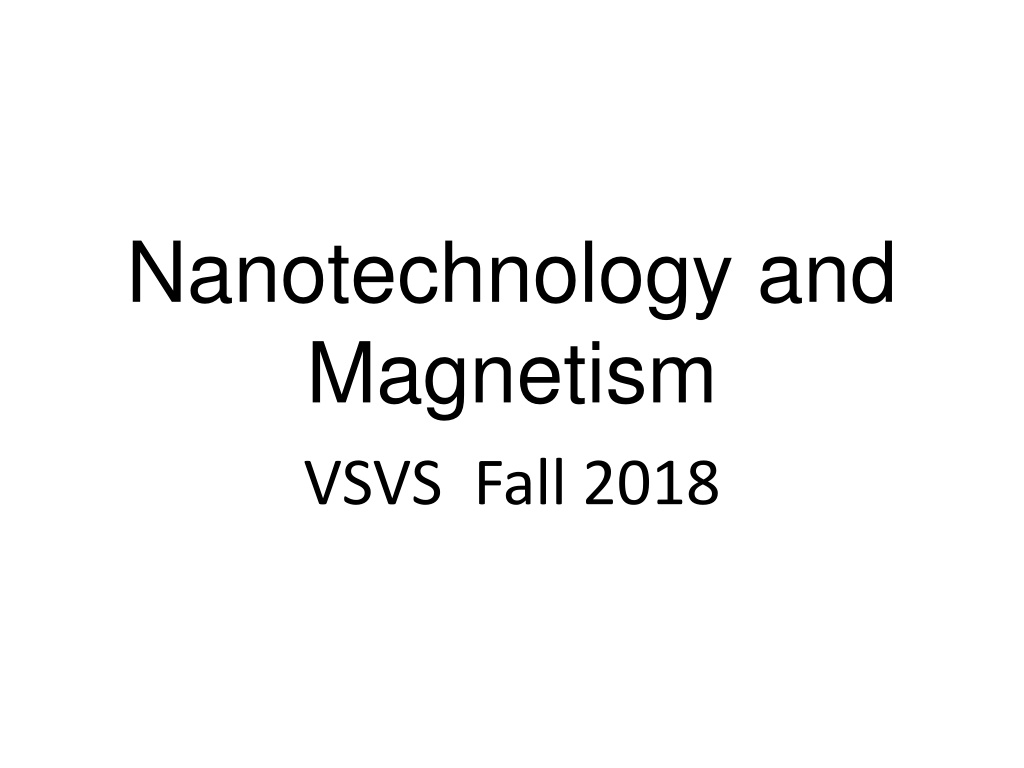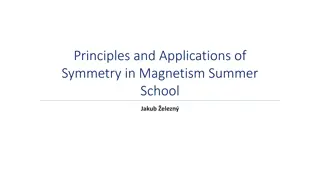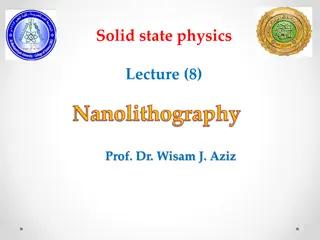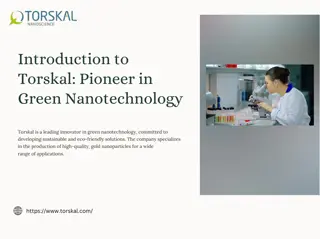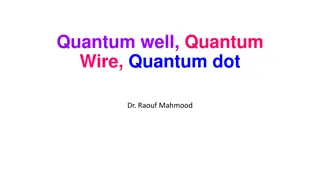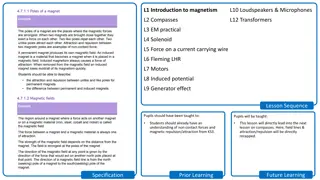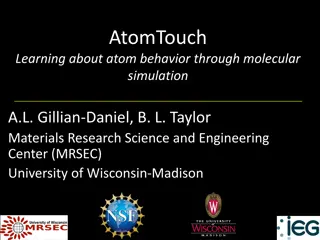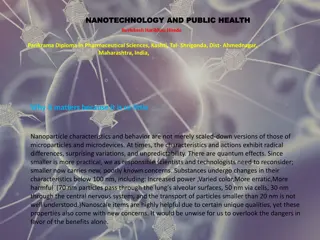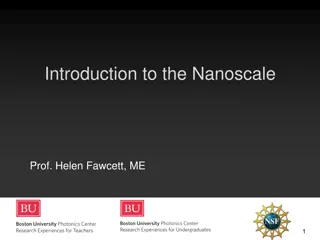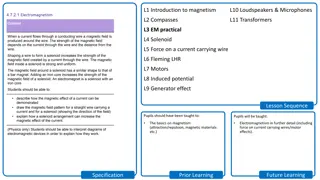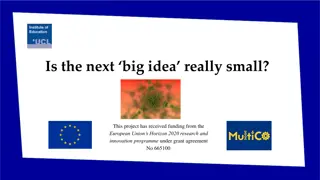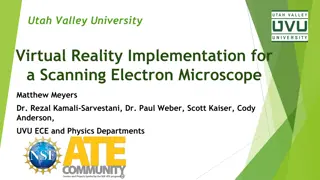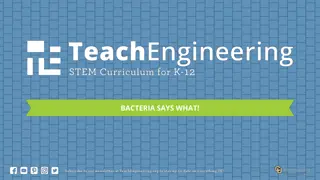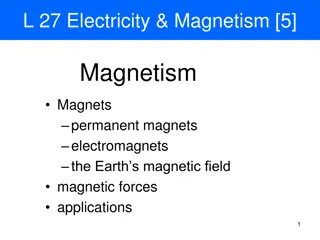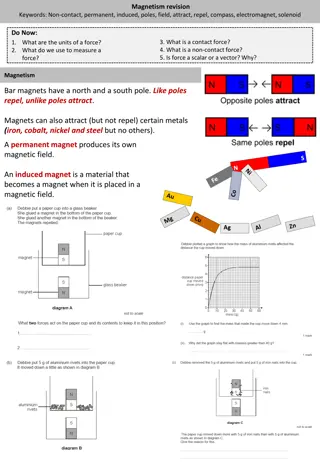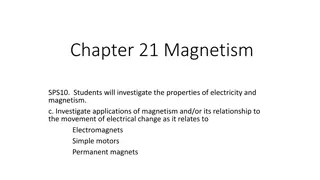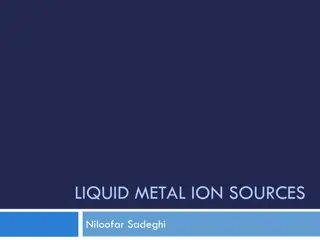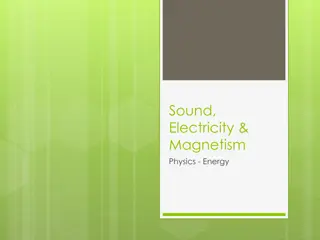Exploring Nanotechnology and Magnetism Applications
Discover the significance of combining nanotechnology and magnetism in various fields such as satellite movements, ophthalmology, and oil spill cleanup. Uncover the principles of magnetism through hands-on activities and discussions on permanent, temporary, and induced magnets. Engage students in practical experiments with magnets to understand magnetic properties and their applications in everyday life.
Download Presentation

Please find below an Image/Link to download the presentation.
The content on the website is provided AS IS for your information and personal use only. It may not be sold, licensed, or shared on other websites without obtaining consent from the author. Download presentation by click this link. If you encounter any issues during the download, it is possible that the publisher has removed the file from their server.
E N D
Presentation Transcript
Nanotechnology and Magnetism VSVS Fall 2018
Why is the science in this lesson important? Ferrofluids are currently being researched for utilization in precise satellite movements in space. The fluid is being shot through needles for extremely specific control. This research is currently in computer simulation stages. In ophthalmology, ferrofluid is starting to be used in research regarding retinal detachment, the leading cause of blindness. Because of ferrofluid s nanoproperties, the fluid has the potential to seal tiny retinal holes that otherwise cause surgeries to be extremely meticulous and delicate. To address the BP oil spill of 2010, oil companies have begun to develop new methods for cleaning up offshore oil spills. When oil mixes with water-repellent nanoparticles containing iron, it can be separated from water. The magnetic fluids attach to the oil particles, and the mixture of oil and water can then be filtered with magnets. This way, the water can be returned to the ocean and the oil can be returned to an oil refinery and reused.
IA. Introduction and Reviewing Magnetism Learning Goals: Students can identify the main magnetic properties and know what permanent, temporary, and induced magnets are. Vocabulary words: magnetism, lodestone, ferromagnetic, permanent magnet, temporary magnet, magnetic induction, magnetic field, ferrofluid, macroscale, nanoscale, nanotechnology These words are on the handout, and can be referred to during the lesson. Ask students: what do you know about magnets? Magnets have north and south poles Similar poles repel, opposite poles attract Some magnets are permanently magnetic vs. temporarily magnetic. Magnets have invisible force fields around them
1B. Magnets Have Poles Activity: Give each group of four 2 wand magnets and 1 ring magnets set 1 pair arranges the ring magnets so they all float 1 pair explores how the wand magnets attract/repel each other Pairs exchange tasks. Write observations on the board Collect ring magnet sets.
IC. Activity Permanent and Temporary Magnets Give each group of four 2 bags containing 5 large paper clips and 2 handouts Ask students if they think that the paper clips are attracted to each other, like the 2 magnetic wands (no). Tell students to use the wand magnet to pick up a paper clip. Ask Why is the paper clip attracted to the magnet? Only materials containing metals iron, cobalt or nickel are attracted to magnets. Adjust the first paper clip so that it hangs down from the end of the wand. Tell students to keep the paper clip attracted to the magnet and to pick up another paper clip so that it hangs from the first. Tell students that the first paper clip is now magnetic by induction. Try adding a 3rdand 4thpaper clip, one at a time, to the bottom clip. Remove the paper clips from the magnet and place on the desk top. Ask students if the paper clips are still magnetic. Tell students to use one of the paper clips and try to pick up other paper clips (without using the magnet). Are the paper clips magnetic after being detached from the wand magnet? Tell students that some magnets are permanently magnetic and some magnets are just temporarily magnetic. The wand magnet is a permanent magnet. The paper clips are temporary magnets.
1D. Magnets Have Fields Give each group of four 2 petri dishes of iron filings, 1 piece of lodestone, and 2 vials of iron oxide powder Tell each pair of students to move the wand magnet around the petri dish, and describe what s happening Repeat this with the lodestone. Shake the petri dish to get iron filings in a thin, even layer, and then place wand magnet underneath Observe the shape the iron filings take around the magnet What items are permanent magnets, and which are temporary? Tell students that the iron oxide powder has the same formula as the lodestone (Fe3O4).
1D. Magnetic Fields cont. Pass out the 3-D magnetic field generators. Make sure the bar magnets are sitting on top of the plastic containers instead of inside. Tell students the plastic containers are filled with iron filings, just like the petri dishes Tell students to insert the bar magnets into the center of the containers and rotate the containers The accumulation of iron filings follows magnetic field lines
II. Magnetism and Nanotechnology Learning Goals: Students understand what ferrofluid is and why it is different from the powdered iron oxide that isn t nano. Hold a vial of the ferrofluid up so that students can see it. Tell them that the black material is called ferrofluid and that ferrofluid is a unique material that acts like a magnetic solid and like a liquid.
III. Nanoscience Learning Goals: Students understand the difference between the macro, micro, and nanoscale and can classify different objects as belonging to one of the categories. Ask students if they know what nanoscience is Focus on things measured in nanometers, like atoms and molecules Pass out How big is your hand? worksheets. Tell students to: Look at the scale. Place their hand against the ruler and read off how many nanometers your hand measures. Tell students to look at the reverse side, showing the sizes of different objects, measured in nanometers. The pictures are designed to show students ways to think about how small a nanometer is. There are 3 categories: Macroscale objects objects we can see with our eyes. Microscale objects we need tools like microscopes Nanoscale objects we cant see them with just our eyes. We need special tools to make images of them. Discuss the sizes of objects in nanometers.
III. Background Information on Ferrofluids Tell students that the ferrofluid and iron oxide powder, have the same formula as the lodestone (Fe3O4). On the macroscale, magnetite, in the form of lodestone, is permanently magnetic. On the nanoscale, magnetite powder is paramagnetic, meaning that it s magnetic only in the presence of a magnet. Hold the vial of ferrofluid up - It s a suspension of coated magnetite particles that acts as a magnetic solid and a liquid Ferrofluids are unique in that they have the magnetic properties of a solid but also the fluid properties of a liquid. The nanoparticles are not affected by gravity, which means they will not settle out. They also become denser in the presence of a magnetic field.
III. Activity: Ferrofluid CAUTION: DO NOT OPEN VIAL. DO NOT SHAKE THE VIAL. Pass out vials of ferrofluid and iron oxide in liquid Hold the wand above the vial of iron oxide suspension, and note what happens does it form spikes? Repeat with ferrofluid can you see the force field ? What happens if you put the side of the magnet near the vial? Ask does the ferrofluid act the same as the iron oxide suspension? Ferrofluid particles are so small that they are not affected by gravity
